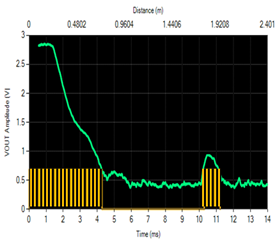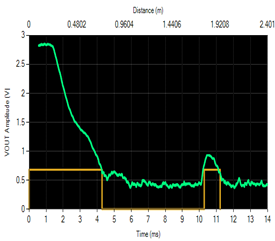Other Parts Discussed in Thread: , MSP-EXP430F5529LP, TDC1000, TDC7200, BOOSTXL-TUSS4440, TUSS4440
Hi guys!
i have some questions about TUSS4470 in order to know if it fits working with my application, one on the RX path and one on the TX path:
1) I saw the analog front-end in the receive path signal mounts a log amplifier, so the shape of the received echo signal is not so important as in TDC1000, but what matters is the TOF signal capture (I read that it is possible to capture echo signal with Vrms with magnitude of dozens of uVolts (maybe due to LNA input noise of the order of nV/√Hz). In the eval board BOOSTXL-TUSS4470 the analog output signal goes to the ADC MCU of the bottom board (MSP-EXP430F5529LP), and it’s shown in the GUI that the minimum resolution in TOF is 1uS, that means that lenght resolution in air is about 1 mm. It seems that this is a limit of the internal ADC (1 MHz), right?
So the question is: have the analog outputs VOUT (pin9) and the other digital signals outputs from internal comparators (OUT3, OUT4) a sort of other time discretization for example in the Sum stage or in other points, or can I consider a fully analog signal path with S/E output (like the LNA + PGA before the COMPIN in TDC1000 that worked so well)?
I mean i would like to know if e.g. is it possible to use one of the digital comparator outputs as a STOP signal for the TDC7200 IC without affecting its native time resolution below 1 nS? TDC1000 + TDC7200 worked so well in this sense so are there any issue on timing resolution using TUSS4470 + TDC7200?
2) My application needs high voltages because the transmission medium is air: concerning BOOSTXL-TUSS4470 can I reach hundreds of volts (obviously depending from the impedance seen by the transformer output at resonance frequency, but not the aim of this question in the hypothesis that is all optimized for the maximum power extitation) without using the external Pre-Driver Fets (not populated on board), but only the transformer drive or are Pre-Driver Fets mandatory for that aim (hundreds of Volts)? It seems the Trasformer Drive is only populated on the BOOSTXL-TUSS4440 right?




